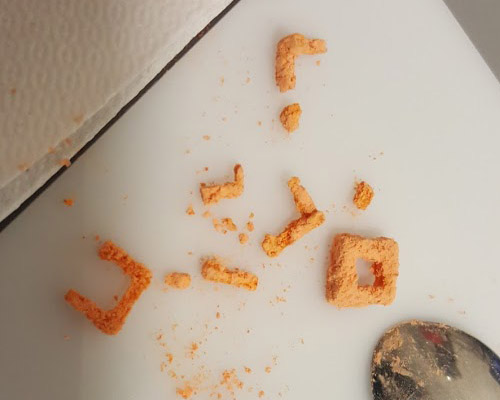Our sweetest project!
A new vision in sweet pastry production
It all started when…
We found out that the interest of 3D printing in the food industry is growing, proved also by our visit to IBA, the leading world fair of bakery and confectionery craft in Munich, on September 2018. At that point we looked at our Lumipocket LT multifunction 3D printer with new eyes. It 3D prints with resin, it is able to engrave soft materials and to etch PCB, why not 3D print food too?
Why 3D printing FOOD
Why is there all this interest in 3D printing and Food? What is the value added 3D printing can bring to the sacred art of cooking and processing food?
First of all, 3D printing allows the creation of complex geometries which cannot be produced in any other way. Even more interesting can be the embedding, meaning to work with two different materials at the same time. With 3D printing, it is possible to incorporate one food geometry into another. For example, a cake that, when cut, reveals a message printed inside.
La food designer Marijn Roovers dice che non avrebbe potuto realizzare i suoi globi di cioccolato senza questa tecnologia, dopo aver creato queste praline con una stampante 3D per l’ estrusione di cioccolato. https://www.nature.com/
Moreover 3D printing allows the creation of a customized composition, which means the possibility to produce personalized dishes for individuals when ordering or costum-made decorations, like real 3D reproduction of spouses, for an original cake top.
The last but not least advantage of using 3D printing in food preparing is Reliability, meaning precise dimension and repeatability. With 3D printing food, the needed tolerances can be achieved. But, the result usually is limited in the texture by the raw material that you are using and the technology– unless you can 3D print fragile structures with sugar…
Most of food 3D printers use extrusion 3D printing technology, like traditional filament 3D printers, but instead of a plastic filaments they use a paste-type ingredients. Most common raw materials are chocolate, pancake batter and cream, 3D printed layer after layer, generally through syringe-like extruders.
What is Lumi Industries’ innovative idea
As mentioned, reliability and repeatability are some of the features requested to a 3D printer and current devices extruding food material can sometimes be not so precise. The innovation here is a complete change of technology: from extrusion to sintering.
Sintering is the process of compacting and forming a solid mass of material by heat without melting it to the point of liquefaction. And this is what is already happening is Metal or Plastic Polymer Laser Sintering additive manufacturing devices (SLS).
Which one could be the raw material for such a process? Of course icing sugar, already used in pastry to create artistic shapes.
The development process
We decided to use Lumipocket LT multifunction 3D printer as the basic hardware for our experiments. The current device is mounting a 40 mW UV laser, which was the perfect starting point to test our ability to actually sinter a powder material.
But not any kind of material. We made some researches and found the correct raw material, a particular icing sugar optimized for similar uses.
Second step was to design an additional component that could be mounted on Lumipocket LT as an accessory able to transform a resin 3D printer and engraver into a laser sintering 3D printer.
New icing sugar laser sintering accessory for Lumipocket LT.
As all powder 3D printers, Lumi Sweet, as we have called it, has a printing bed where the 3D printed part will be created layer by layer and a container for the raw material, meaning icing sugar in our case. The level of the printing material rise while the 3D printing bed lower, when each layer is completely “sinterized”, solidified through the laser power. This movement is controlled by a software we wrote, and managed trough motors allowing the the container and the printing bed to move up and down according to the layer height we have set. After this, a rotating bar will turn around to move, distribute and compact a new layer of sugar powder on the 3D printing bed. In This experimental version, at every layer, the Laser moves on a CoreXY system, as in Lumipocket LT, designing 3D model outline and with its power, turns the icing sugar powder into solid sugar.
The whole accessory parts were 3D printed with an FFF printer and mechanical components installed to start the first sugar sintering experiments.
First Icing sugar sintering tests
CONCLUSIONS
First tests made with this very “Maker Friendly” accessory device were very promising. Laser had to be used at its full power and timing had to be slowed down to allow the sugar to transform from powder into a solid mass.
A more powerful laser should be used, while a stronger rotating bar should be installed, to be able to compact more the sugar and having a stronger adhesion between layers.
However we can certainly say that: IT COULD WORK!
The Lumi Sweet project, at its early stages,was first showcased at European Maker Faire Rome in 2018. It was an incredible success of interest and it was awarded, together with The New Lumifold, by Caleb Craft, chief editor of Make Magazine, the Maker of Merit Prize 2018.
Caleb Craft awarding Davide Marin. Lumi Industries CEO with the Maker of Merit 2018 award at Maker Faire Rome.
next steps
At the moment the project is at early stage and we are looking for partner companies interested in supporting a further development of this incredible idea which is going to allow pastry chefs to create amazing and incredible geometries they could never even think about it with any other traditional way of production.
With Lumi Sweet, the limit will become the chef’s fantasy only!
Contact us to get more information about this project.






